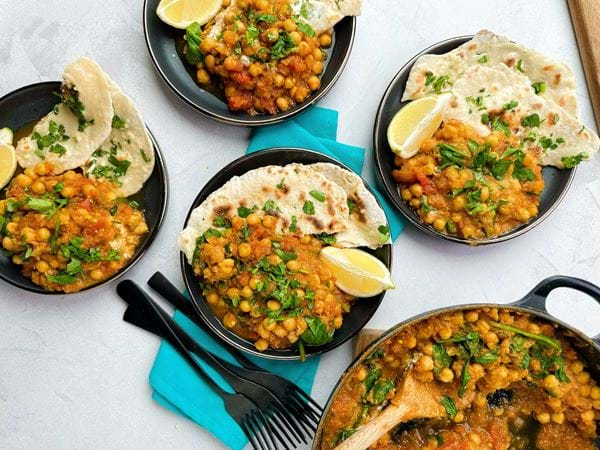Tips For Healthy Eating When Dining Out

Page last updated: 7th November 2023
Healthiest Types Of Restaurant Food | Healthy Menu Choices | 10 Ordering Tips | Benefits Of Eating Slowly | Healthier Dessert Options
Nothing beats going out for a good meal. In fact, Brits eat out on average 1.5 times a week, showing that we just can’t resist dining out at a pub, cafe or restaurant[1].
While it’s perfectly fine to indulge every now and then, if you’re looking for some healthy options from the menu, it can be hard to know what to pick. To make it easier for you to choose the healthier option the next time you join family or friends for a social dinner, here are our top tips for healthy eating when dining out.
How To Eat Healthy While Eating Out
Choosing A Healthy Restaurant
Which pub, cafe or restaurant you pick might not always be up to you if it's a work do or friend's birthday meal. However, if you do have a say in the choice of where you’ll be eating, compile a shortlist of local venues, then compare their menus online until you find the one with the best choices for your healthy lifestyle.
5 Of The Healthiest Types Of Food To Eat Out
The types of cuisine you choose to go for can make a big difference in how easy it will be to pick healthy eating out options. Here are some of the healthiest types of food to eat when you go out:
- Japanese: with traditional dishes like sashimi, sushi and grilled fish, Japanese food in well known for its focus on fresh, raw ingredients, lean proteins and minimal use of unhealthy fats. Food like ramen can be relatively low in calories, and menus regularly include a variety of vegetable and seaweed-based dishes like salad and miso soup.
- Greek: renowned for its emphasis on fresh and simple ingredients, healthier Greek dishes include Greek salad, with feta cheese, olives and fresh veggies, grilled fish and lean lamb or chicken souvlaki (skewers).
- Spanish: probably the type of food you think of when you picture Mediterranean cuisine, Spanish dishes have a firm focus on seafood, heart-healthy olive oil and fresh produce. Healthy choices include grilled or roasted fish, gazpacho and dishes like paella, made with plenty of vegetables and lean proteins.
- Thai: with a delicious balance of flavours, Thai dishes include plenty of herbs and spices, often with lean protein, such as chicken or shrimp, and a variety of healthy vegetables. Thai soups, like Tom Yum, are often low in calories and packed full of flavour.
- Italian: using plenty of fresh ingredients and a variety of vegetables, herbs and whole grains, if you skip the pizzas and heavy cream-based pasta dishes, you can enjoy a healthy Italian lunch or dinner. A caprese salad, with tomatoes, mozzarella and basil, as well as grilled seafood, vegetable based pasta dishes and minestrone soup are all great options for a healthy meal out.
Check The Menu For Healthier Choices
Once the venue is booked, take a look at the menu and plan what you're going to order. Most restaurants have the menus up online, and many now have the nutritional information available, so you can make an informed decision. Having a few options to choose from means you have more flexibility on the day depending on what you are in the mood for, and what is available.
Remember, it's not just about choosing the healthiest or lowest calorie option on the menu - make sure you are going for something you will enjoy! Sometimes a smart choice can be swapping chips for a healthier side, rather than going for a salad that won't satisfy you.
Top 10 Ordering Tips
When the time comes to order your food, keep these top 10 tips in mind so it’s easier to make healthy choices when eating out:
- Ask for dressing on the side: salads and vegetables can be drenched in dressing or butter. Asking for this to come on the side means you can add the amount you want.
- Pick nutrient-packed wholegrain: if you can't resist the basket of bread, ask for the wholegrain variety rather than white - it’s high in fibre, vitamins and minerals.
- Limit salt intake: too much salt can raise your blood pressure [2] and cause water retention, but you can ask for the chef to hold back on adding salt to your food.
- Pick veggies over cream: opt for a tomato or vegetable-based sauce instead of creamy options, such as carbonara, which can have a high fat content.
- Boiled beats fried rice: if your dish comes with rice, ask for boiled instead of fried rice as it's lower in fat and full of vitamins and minerals.
- Choose a thicker cut of chips: if your main comes with a side of chips, ask for thick cut chips which absorb less fat than thin cut chips. [3]
- Swap in sweet potatoes: some restaurants may swap your side of chips for sweet potatoes, which are high in fibre, a great source of Vitamin C and B vitamins, and very tasty. [4]
- Or, more vegetables or salad: alternatively, you could swap your side of chips or potatoes for a salad or extra vegetables.
- Drink soft drinks: a large glass of wine can contain 228 calories [5] and it's quick to add up. Stick to soft drinks, or alternate wine with water so you don't drink as much without realising.
- Select more dishes in smaller portions: some restaurants will allow you to do starter size portions of main dishes so you can order a few small dishes and try everything you fancy without eating large amounts.
Eat Slowly
How you eat your food can actually have an effect on how much you eat when you’re dining out. This can help you consume fewer calories and digest the food better, as chewing slowly helps break down the nutrients from the food making it easier for your body to absorb them [6]. You’re also more likely to be aware of when you’re feeling full if you eat slower, as you give your body more time to register that you’ve had enough to eat.
And, ultimately, it should help you appreciate that food a bit more, as you can pay more attention to every bite.
Pick A Healthier Dessert
You don’t have to forgo a dessert options when you eat out at a restaurant, but if you’re keen to pick a healthier option, it can be tough to find a choice that isn’t loaded with sugar, fat and calories. While sharing a dessert with your dining companion can be a great way to satisfy your sweet tooth with half the calories, there are also some healthier dessert choices you can make, including:
- Fresh fruit: fruit plates or fruit salads are typically low in calories, fat and sugar and provide natural sweetness and vitamins
- Sorbet or frozen yogurt: these options are often lower in fat than regular ice cream and can be a lighter, fruit-based alternative
- Dark chocolate: dark chocolate contains less sugar than milk chocolate, so if you’re after a chocolate fix, opt for desserts that contain dark chocolate in moderation, like a chocolate mousse.
For more healthy meal ideas, check out our recipes pages or our nutrition and diet advice hub for more tips. If you need help with your nutrition or training, why not work with a Personal Trainer? They can help you to reach your diet and fitness goals and provide expert advice tailored to your needs.
Ready to workout? Find your closest PureGym here and get started today.
[1] https://press.opentable.co.uk/brits-fork-out-one-quarter-of-their-annual-income-dining-out/
[2] https://www.nhs.uk/Livewell/Goodfood/Pages/salt.aspx
[4] https://www.bbcgoodfood.com/howto/guide/health-benefits-sweet-potato
[5] https://www.drinkaware.co.uk/alcohol-facts/alcoholic-drinks-units/wine/


